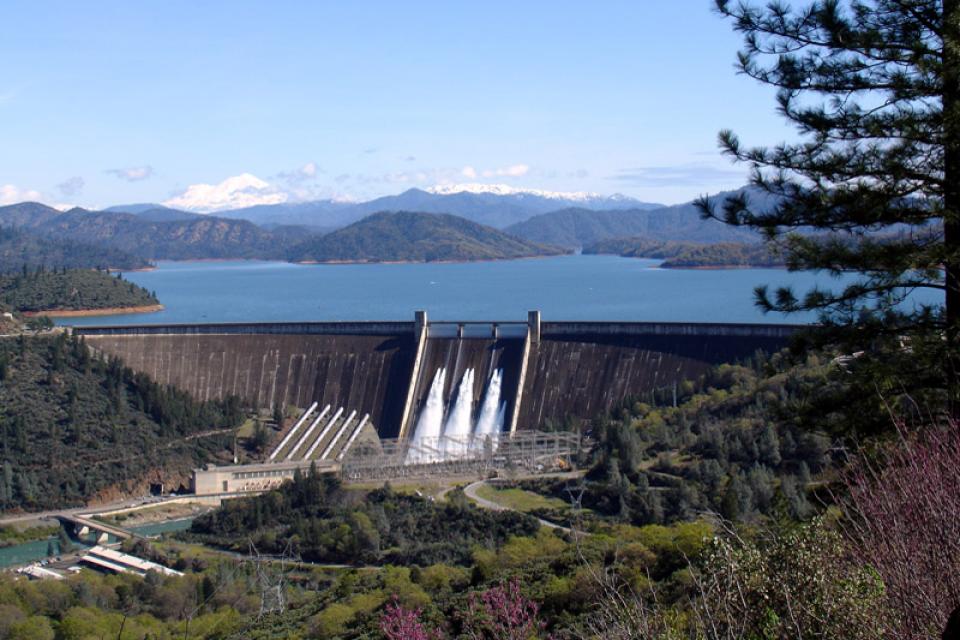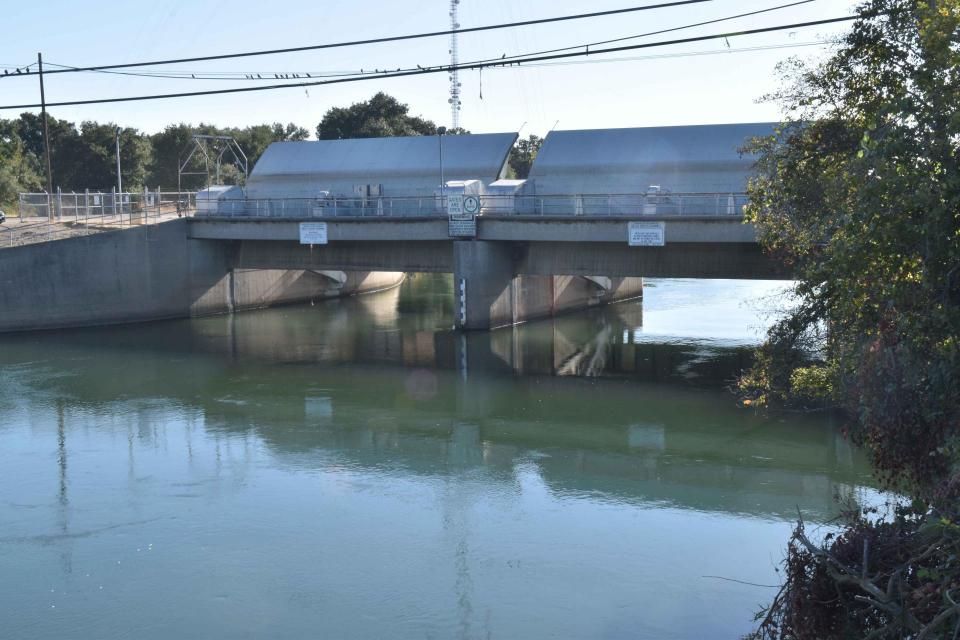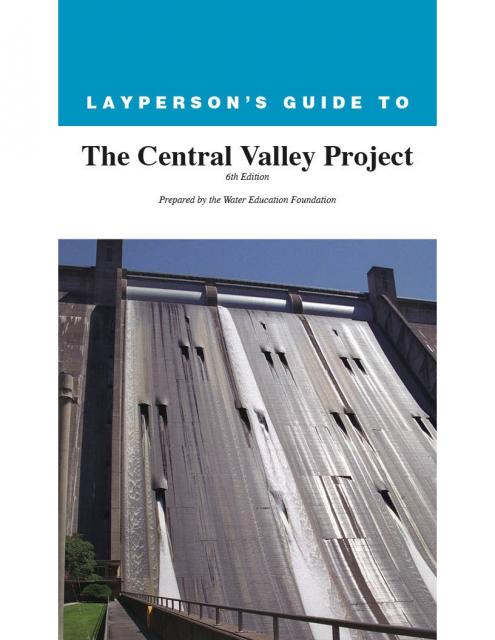Central Valley Project
 Birthed in part by a long-ago federal
effort to create farmland, the Central Valley Project today is
one of the largest water storage and transport systems in the
world. In years of normal precipitation, it stores and
distributes about 20 percent of the state’s developed water
through its massive system of reservoirs and canals.
Birthed in part by a long-ago federal
effort to create farmland, the Central Valley Project today is
one of the largest water storage and transport systems in the
world. In years of normal precipitation, it stores and
distributes about 20 percent of the state’s developed water
through its massive system of reservoirs and canals.
Water is transported 450 miles from Shasta Lake in Northern California to Bakersfield in the southern San Joaquin Valley. Drawing mainly from the Sacramento and the San Joaquin river basins, the CVP features 20 dams and reservoirs along with numerous components of water storage and conveyance infrastructure.
The CVP features a combined storage capacity of 11 million acre-feet, 11 power plants and three fish hatcheries. On the San Joaquin Valley’s east side, the CVP’s Friant Division serves about 15,000 farms on more than 1.5 million acres of land and supplies several cities, including Fresno.
In an average year, the CVP delivers more than 7 million acre-feet of water to farms, cities and the environment. About 75 percent of CVP water is used for agricultural irrigation that supports seven of California’s top 10 agricultural counties. The CVP’s hydroelectric powerplants generate about 4.5 billion kilowatt-hours of electricity in an average year, which is approximately equivalent to the annual residential needs of about 1.5 million people. The CVP also dedicates 800,000 acre-feet per year to fish and wildlife habitat and 410,000 acre-feet per year to state and federal wildlife refuges and wetlands.
More broadly, the CVP’s benefits touch the lives of anyone who buys grapes, lettuce, almonds, canned tomatoes or a cotton shirt made from Central Valley crops. Because of the CVP and California’s State Water Project (SWP), the Central Valley has become the richest agricultural region in the nation.
The widespread availability of water and hydroelectric power also has created millions of jobs and yielded untold billions in manufacturing and commerce.
The CVP’s major redistribution of water, however, has not occurred without controversy. Conflicts have long festered over the project’s public costs and private benefits, and its effect on the environment.
Central Valley Project Background
The CVP got its start in 1933 as a state-funded project to manage flooding, store water and produce electricity. But the CVP ran into Depression-era financing difficulties. Attempts to obtain federal grants and loans failed, and the state asked the federal government to take over.
Subsequently, dams and reservoirs were constructed for river regulation, navigational improvement and flood control.
Currently, major CVP projects include:
- Shasta Dam and reservoir on the Sacramento River,
- Trinity Dam and reservoir (formerly called Clair Engle Lake) on the Trinity River
- Folsom Dam and reservoir on the American River
- Friant Dam and reservoir on the San Joaquin River
- New Melones Dam and reservoir on the Stanislaus River (which helped galvanize the river-preservation movement in California)
- San Luis Reservoir, a joint federal-state storage offstream facility.
The federal government has financed nearly all construction costs on most CVP projects, and state and local agencies are providing reimbursement of costs over several decades.
As a result of a 2016 change in federal law, the Bureau of Reclamation allows the conversion of water service contracts to repayment contracts upon a contractor’s request and authorizes prepayment of outstanding CVP construction costs. Full repayment is due within three years of the contract conversion.
Learn more about the history of the Central Valley Project in this video.
Central Valley Project Controversies and Challenges
The CVP has brought with it controversy over how to address the needs of agriculture and provide water for a huge populous while also sustaining the environment.
The Central Valley Project Improvement Act (CVPIA) of 1992 enabled 19 state, federal and privately owned wildlife refuges stretching from Glenn County in the Sacramento Valley to Kern County in the San Joaquin Valley to regularly provide critical managed wetland habitat. Prior to the CVPIA, most of the refuges relied upon surplus water storage, agricultural return flows, junior water rights and groundwater for their supply, all sources that were either unreliable, of marginal quality, or both.
CVP plans initially included a canal to collect irrigation drainage from farms on the west side of the San Joaquin Valley, but the drain was never completed.
For years, farmers kept salt from building up in the soil and shallow groundwater by installing underground drainage facilities. However, the salty drainage water contains selenium, which can reach levels toxic to birds when concentrated in an evaporation pond or other drainage facilities. The water wound up in Kesterson Reservoir in the 1980s, with subsequent high concentrations of selenium in aquatic plants and insects. Concentrations in some waterfowl food plants were up to 64 times those deemed to be a health hazard to birds. Thousands of birds died or suffered mutations.
After three years of cleanup, more than 1 million cubic yards of clean soil had been used to cover and bury the contaminated soil. Today, concentrated agricultural irrigation runoff from the west side of the San Joaquin Valley is used to grow salt-tolerant crops, but providing adequate drainage for agricultural stormwater remains a challenge.
Eventually, several farmers in the Westlands Water District sued the federal government for not providing promised drainage. A federal judge ruled in the farmers’ favor in 2000 and the parties eventually agreed to a settlement in 2015 that will relieve the district of its CVP construction debt. Among other conditions, the district must retire at least 100,000 acres of farmland and assume responsibility for managing agricultural drainage within its sprawling service area. The settlement is still pending Congressional approval.
Due to its role in providing two-thirds of the state’s drinking water, the Sacramento-San Joaquin Delta is where much of the concern is focused. The Delta, of course, is the hub of California’s water system, the epicenter through which water flows to the CVP and SWP.
Climate change and drought are adding to the CVP’s many difficult challenges by reducing snowfall and altering runoff periods in the Sierra Nevada. As a result, it’s become increasingly difficult for the CVP to fulfill the requests of its water contractors, particularly during drought years. For example, in 2021 and 2022 Reclamation was unable to provide any water to most of its agricultural contractors.
Fish and the Central Valley Project
Also generating controversy, populations of chinook salmon in the Sacramento and San Joaquin river basins have significantly declined since the late 1980s. The winter-run Sacramento River chinook are classified as endangered under the state and federal Endangered Species Acts (ESA). In 1998, spring-run chinook were listed as threatened. [See also Anadromous Fish Restoration.]
While mitigation plans and facilities have been a part of the CVP since the early 1940s, these efforts to save the winter-run chinook salmon, in combination with the Central Valley Project Improvement Act, brought fundamental change to CVP operations.
 State-of-the-art fish screens were
installed on the Sacramento River and at large diversion canals.
In the Delta, gates at the Delta
Cross Channel also are closed for several months to reduce
fish being drawn toward the export pumps.
State-of-the-art fish screens were
installed on the Sacramento River and at large diversion canals.
In the Delta, gates at the Delta
Cross Channel also are closed for several months to reduce
fish being drawn toward the export pumps.
Other winter-run chinook recovery strategies include captive breeding programs, improving historic spawning grounds with fresh gravel and giving juvenile salmon better rearing habitat by restoring floodplains and wetlands. Meanwhile an $80 million temperature control device installed at Shasta Dam helps cool Sacramento River flows during the summer and the Coleman and Nimbus fish hatcheries have been modernized with new technology.
In 2006, an agreement between the federal government and Friant Division contractors on one side and Natural Resources Defense Council, which filed suit, was reached to restore water flows for salmon in the San Joaquin River below Friant Dam near Fresno. The pact provided funding for substantial river channel improvements and water to sustain a salmon fishery upstream from the confluence of the Merced River tributary while providing water supply certainty to water contractors.
Operations of the CVP are subject to rules and regulations governing the protection of endangered fish such as chinook salmon.
In 2019, biological opinions issued by the federal government under requirements of the federal Endangered Species Act concluded that the continued operation of the SWP and the CVP would not jeopardize threatened or endangered species or adversely modify their designated critical habitats. California and some environmental groups challenged the validity of those biological opinions in a lawsuit and a federal court in 2020 prohibited Reclamation from implementing them. Reclamation consulted with the U.S. Fish and Wildlife Service and the National Marine Fisheries Service on the next long-term operation plan for the CVP.
On Nov. 15, 2024, Reclamation released the final environmental impact statement for the Long-Term Operation of the CVP and SWP with alternatives reflecting a range of options for the operation of dams, powerplants, and related facilities of the CVP and Delta facilities of the SWP.
The preferred alternative included a “new framework for Shasta Reservoir operations to benefit winter-run Chinook salmon; revised operational criteria for Delta exports that supply water to cities, farms, and wildlife refuges and supports implementation of the Healthy Rivers and Landscapes Program, to provide more Delta outflow/habitat restoration in the Sacramento-San Joaquin Bay-Delta.”
In December 2024, NMFS concurred in its biological opinion that “the proposed action is not likely to jeopardize the continued existence of Sacramento River winter-run Chinook salmon, Central Valley spring-run Chinook salmon, California Central Valley steelhead, Southern distinct population segment of North American green sturgeon, or Southern Resident killer whales, or destroy or adversely modify their designated critical habitats.”
Updated September 2025









